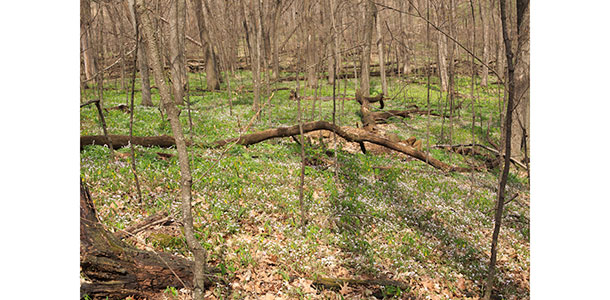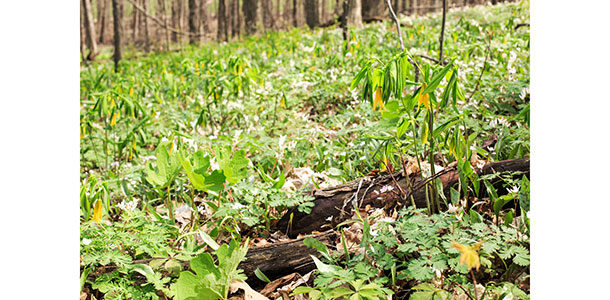Wooded pastures need “health checkups” just like open pastures do, according to Keefe Keeley, an agroecology graduate student at the University of Wisconsin – Madison.
Keeley grew up in southwest Wisconsin watching farmers use woods to pasture cattle. When he became a researcher, he wanted to help farmers increase their returns when grazing woodlands, and help them protect their resources.
Each wooded area is different, he says, but generally open-canopy woods, if there is some sod and brush in the understory, are resilient to some grazing if well managed.
Closed-canopy woods and the ground cover plants and soils in them are often more sensitive to livestock damage and should not be heavily grazed. He says the types of trees also make a difference, and many trees, such as maples, have most of their roots near the soil surface where they can be damaged by livestock overuse.
But Keeley said the resiliency to grazing varies from farm to farm. “The impacts of livestock use in woodlands will vary based on many factors: types and ages of trees, understory vegetation, steepness and direction of hill slopes, drainage, soil type, as well as history of fire, logging and grazing.
“One handy rule-of-thumb for quickly assessing the health of many types of woods is to look for an abundance and variety of wildflowers, especially in the springtime,” he says.
“In all types of woods, pay attention to what your livestock are doing to the soils and plants. Minimizing the negative impacts of grazing on sensitive areas can help protect your land and resources,” Keeley says.
The most easily recognized sign of over-pasturing is bare soil, but there are other important indicators, as well:
- Look for signs of erosion susceptibility, which include soil compaction, runoff gullies and areas of bare soil without plant cover or leaf litter.
- Watch for increased runoff from diminished infiltration and retention, which can cause erosion, exacerbate drought and even dry up springs.
- Valuable trees, both young and mature, should be watched for injured roots and bark removal.
- Watch for population increases of plants your herd finds unpalatable, including some invasive species.
- Mammals, birds and other wildlife often decrease with overgrazing.
“If you noticed more than one of these indicators in your pasture, it’s time to consider alternative management strategies,” Keeley says.
Cattle producers may want to consider silvopasture. Keeley explains silvopasture (“silvo” is Latin for forest) is the intentional integration of trees, forages and cattle intensively managed as a single system.
“It is not ‘turning the cattle out into the woods’ with limited management,” he says.
“Silvopasture systems are designed and managed to maximize the returns from growing tree crops and raising livestock in the same space while caring for soil, water and biotic resources.”
According to USDA National Agroforestry Center, “Well-managed silvopastures employ agronomic principals, typically including introduced or native pasture grasses, fertilization and nitrogen-fixing legumes, and rotational grazing systems that employ short grazing periods which maximize vegetative plant growth and harvest.”
Keeley offers a few guiding principles to be kept in mind in management of woodland grazing:
- Woodland plants are slow to recover from grazing.
- Generally, limited grazing periods with longer paddock rest intervals help minimize resource damage.
- Timing of grazing is critical: spring grazing can cause compaction of wet soil and damage to wildflowers.
- Avoid creating extra edges or otherwise fragmenting large tracts of interior woodland wildlife habitat.
Although silvopastures are management intensive, the benefits can be many. The Agroforestry Center says the payback can include shade for livestock, shorter timber rotations because of competition control and fertilization, supplemental forage, greater plant uptake efficiencies and diversification of income.
Although the principles are the same, silvopasture management and benefits do vary by region. Silvopastures in different areas of the U.S. have very different varieties of trees, such as hardwoods in the northeast and coniferous and nut trees in the southeast. The best types of grasses to plant with the trees also varies.
Keeley urges farmers to research silvopasture practices before starting. To learn more, contact grazing and forestry specialists or your local conservation and extension offices, or go to the University of Missouri's Center for Agroforestry website or visit the USDA National Agroforestry Center website. FG
PHOTOS
This healthy woodland groundcover with abundant spring wildflowers in Wisconsin can be incorporated into livestock pasture rotations. Photos by Ray Pfeiffer.
Kelli Kaderly-Boylen is a freelance writer based in Iowa.











